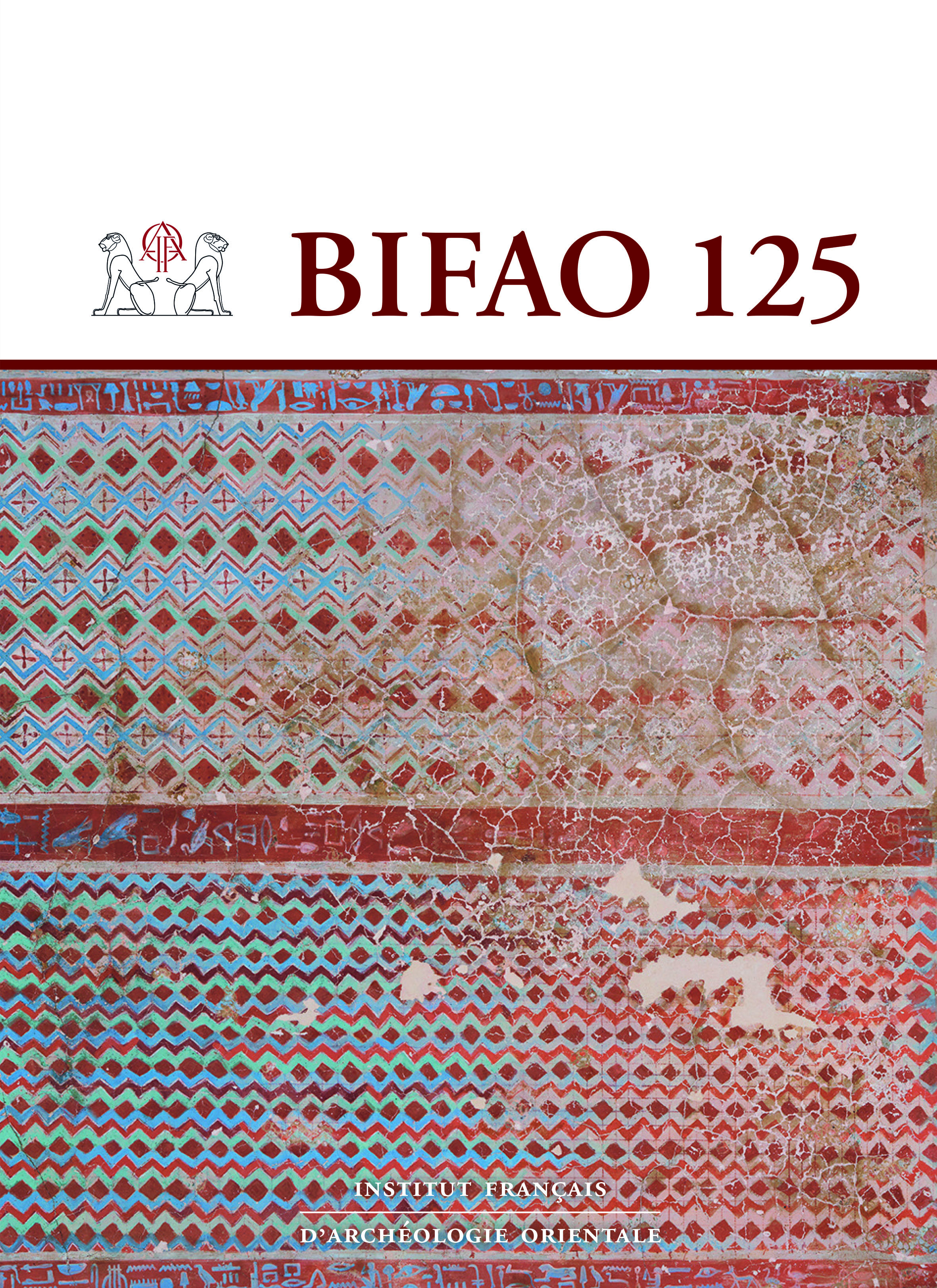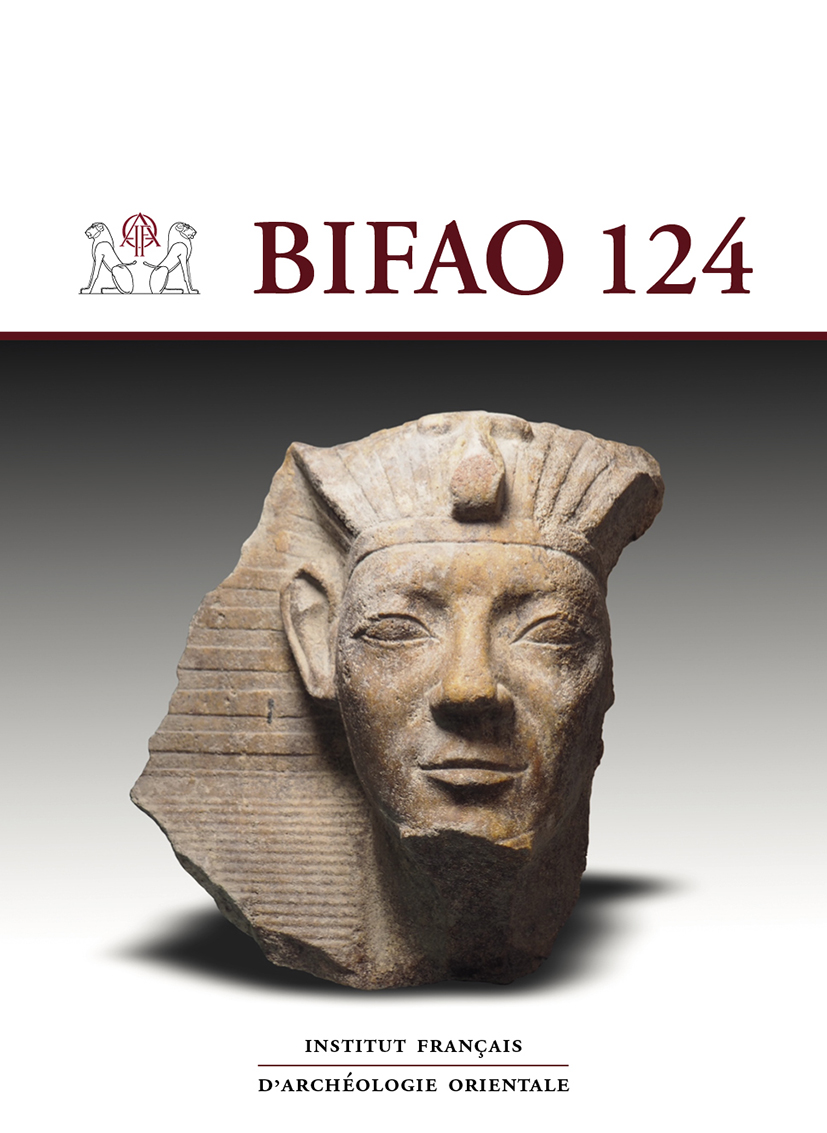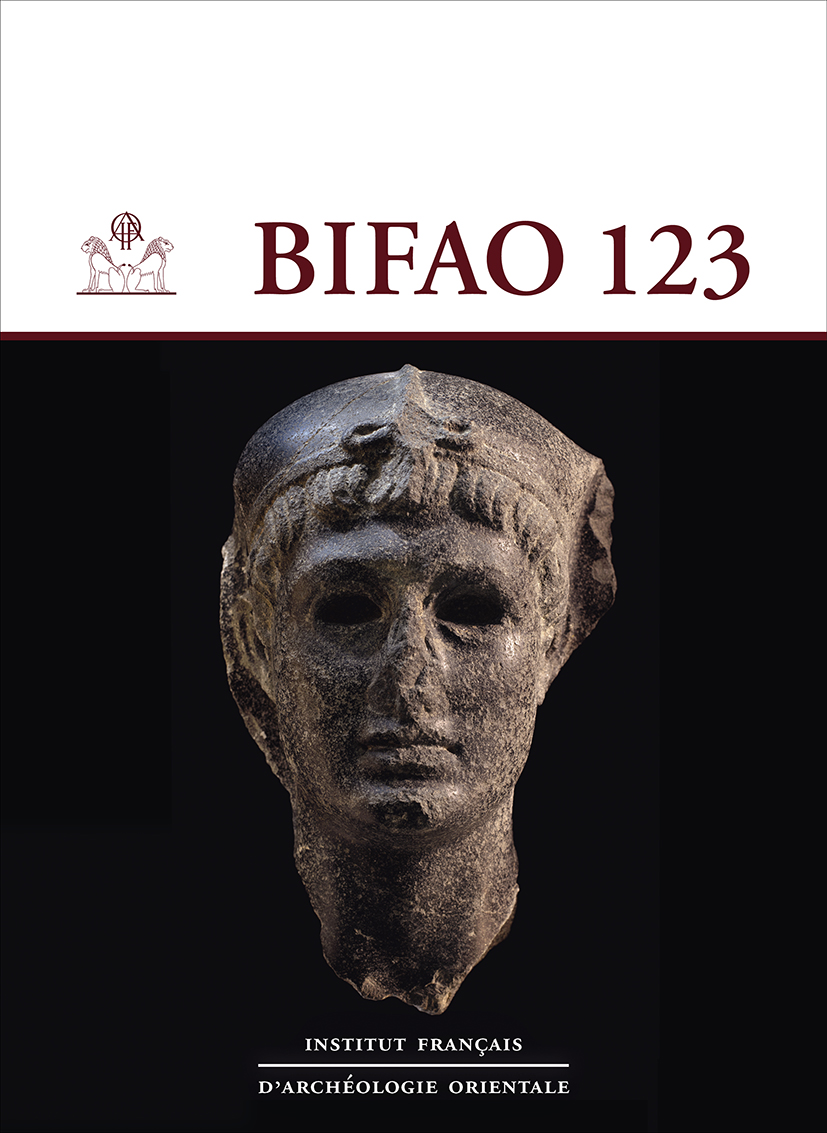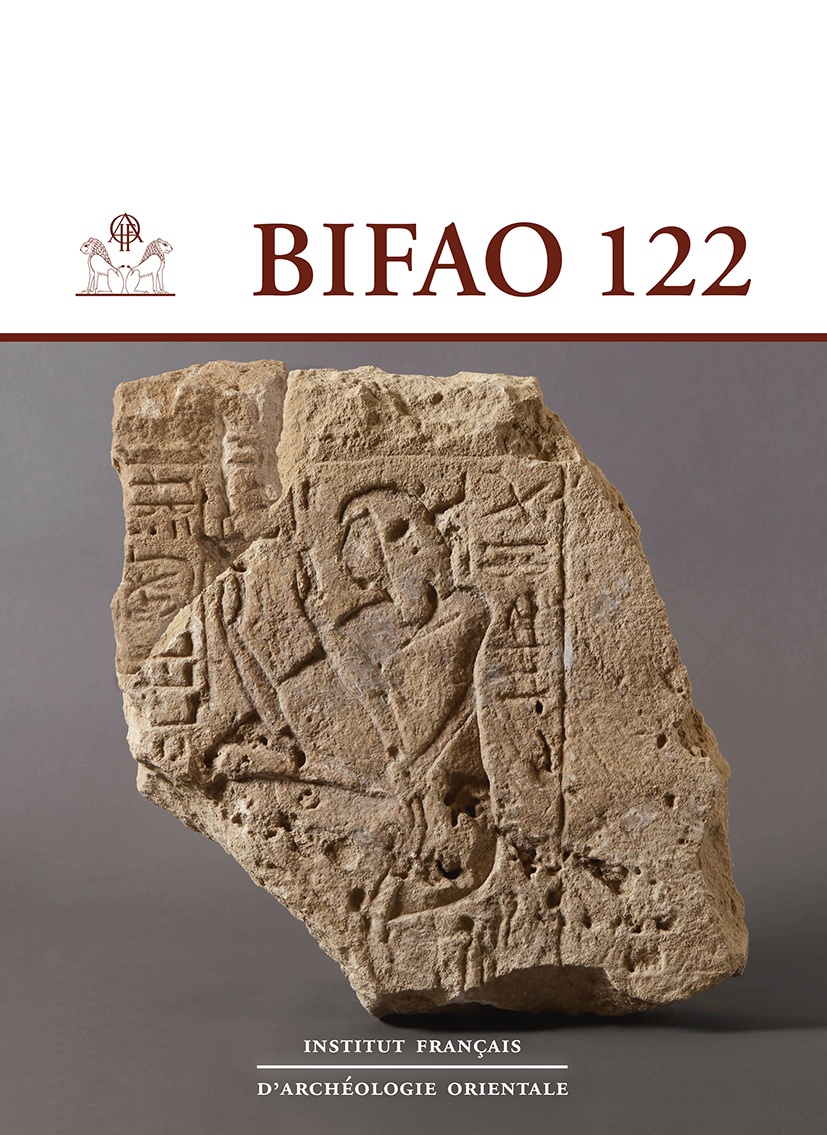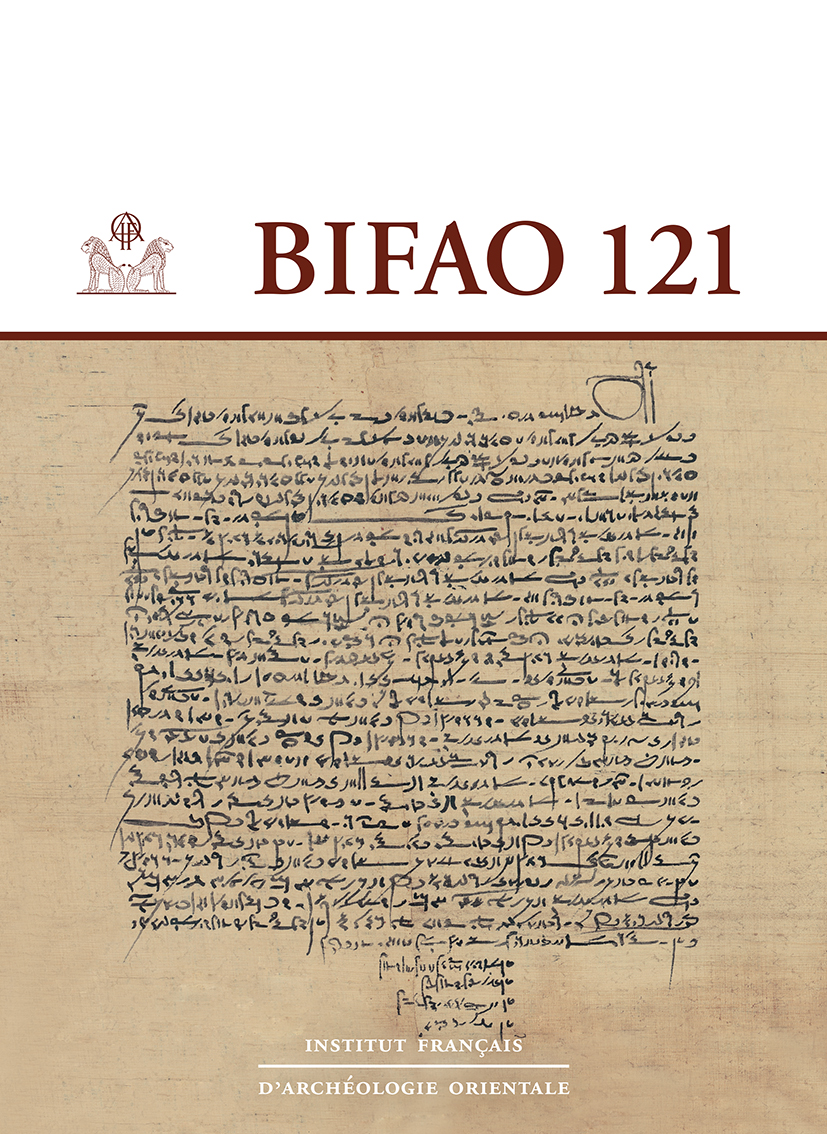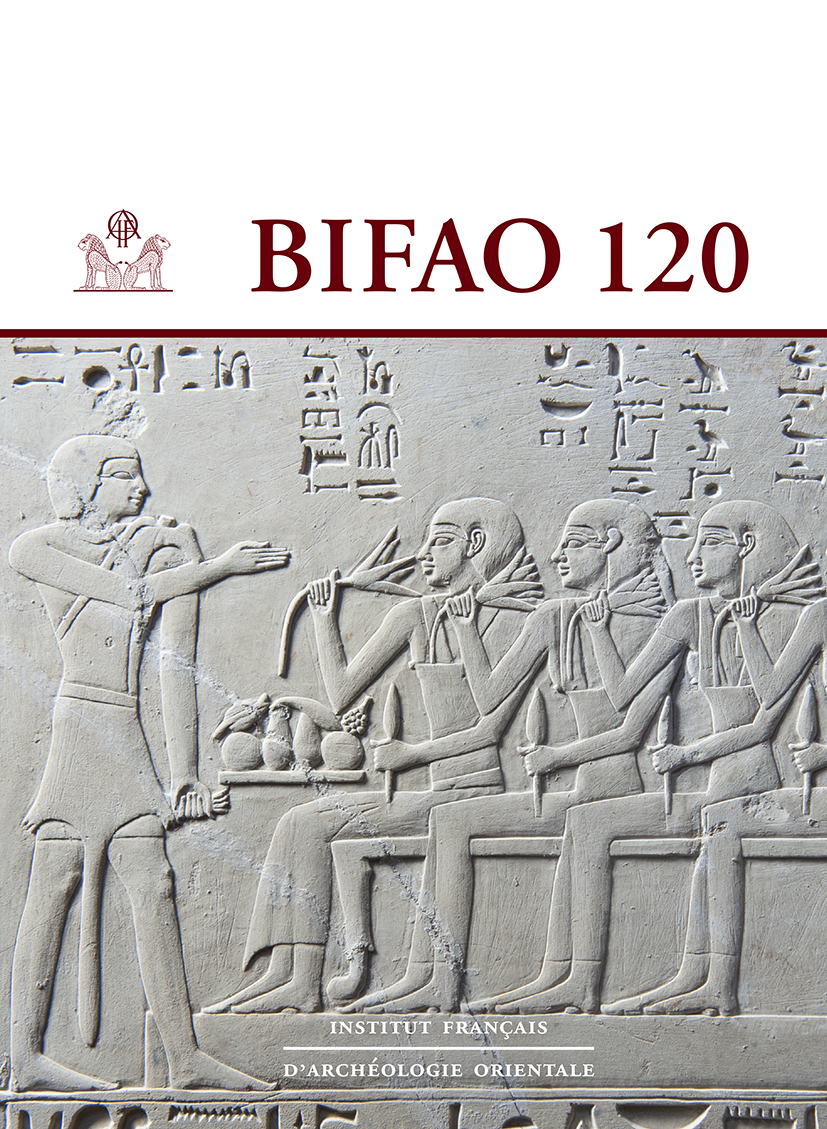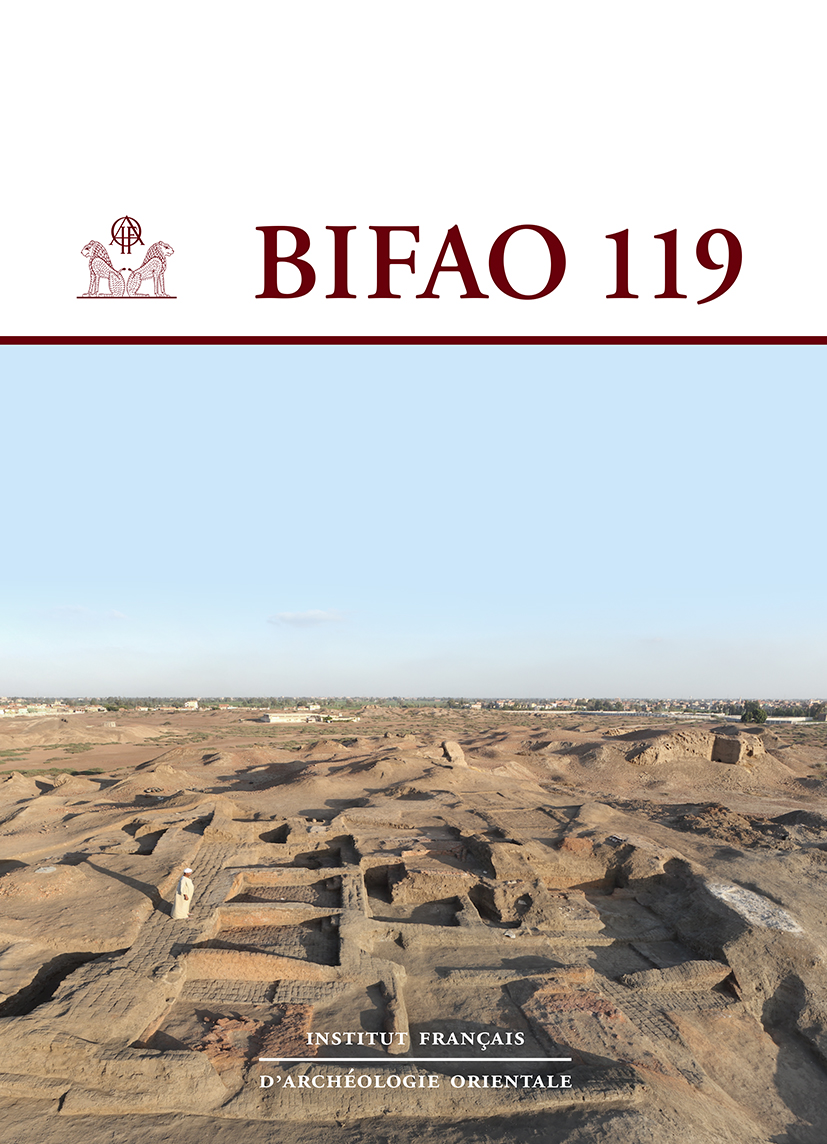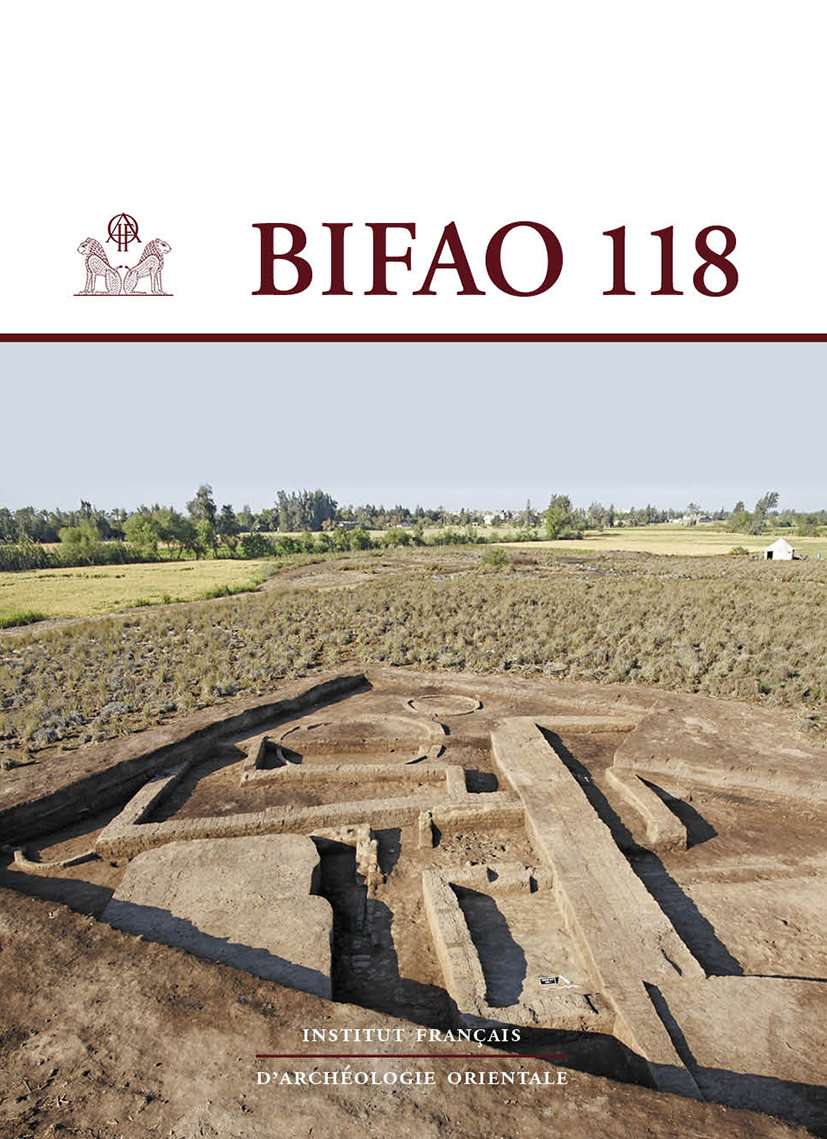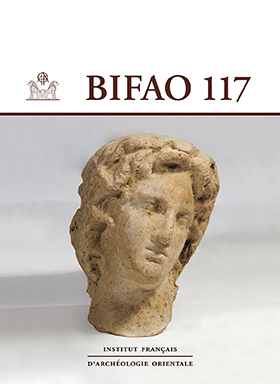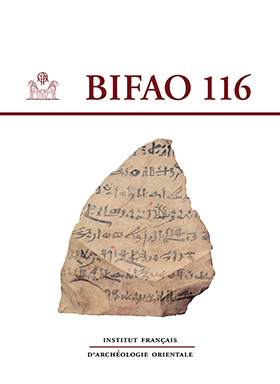Catalogue des publications
- Pour effectuer une commande, remplissez votre panier puis terminez votre commande. Vous pourrez effectuer un paiement sécurisé et être livré dans le monde entier. J’ai un code promotionnel
- To perform an order, fill your cart then proceed the order. You will be driven to a secured page for the electronic payment which includes worldwide shipping fees. I have a promotional code.
Bulletin de l’Institut français d’archéologie orientale (BIFAO)
Le Bulletin de l’Institut français d’archéologie orientale (BIFAO) publie chaque année, en français, anglais et allemand, des études qui illustrent l’état des recherches les plus actuelles dans le domaine de l’égyptologie depuis sa première publication en 1901. Il couvre l’ensemble des champs de la discipline (histoire, archéologie, art, philologie, religion, etc.) sur une période allant de la préhistoire jusqu’à la fin de la période byzantine en Égypte.
Voir aussi le BIFAO en ligne
ISBN 9782724711066
2025 IFAO
Collection: BIFAO 125
Langue(s): français
1 vol. 592 p.
120 € (6000 EGP)
BIFAO 125
Le Bulletin de l’Institut français d’archéologie orientale (BIFAO) couvre l’ensemble des champs de l’égyptologie depuis sa première publication en 1901. Les études qui y paraissent, dont l’aire chronologique s’étend de l’Égypte prédynastique jusqu’à l’époque byzantine, illustrent l’état des recherches actuelles dans les domaines de l’archéologie, l’épigraphie, la lexicographie, l’histoire de l’art, la religion et la philologie.
À noter, parmi les 16 contributions de ce numéro, cinq articles portant sur :
- des centaines de sépultures de la nécropole de Naqada jusqu’ici pensées vides ;
- le papyrus érotique de Turin, sujet à une nouvelle interprétation ;
- la stèle de Takana, l’interprète du babylonien de Toutânkhamon ;
- l’identification possible à Giza de la tombe de Dedi, mentionné dans les papyrus de la mer Rouge, et celle du propriétaire du papyrus du Livre des Morts HM 84123.
The Bulletin of the French Institute of Oriental Archaeology (BIFAO), which made its first appearance in 1901, covers all fields of Egyptology. Studies published in the BIFAO, extending chronologically from prehistory to the Byzantine period, illustrate the present state of research in the disciplines of archaeology, epigraphy, lexicography, history of art and philology.
Among the 16 contributions in this issue are five articles on:
- Hundreds of burials in the Naqada necropolis, hitherto thought to be empty;
- Museo Egizio Papyrus Turn 55001 revisited;
- Tutankhamun's 'interpreter of Babylonian' Pakana;
- The possible identification in Giza of the tomb of Dedi, mentioned in the Red Sea papyri, and that of the owner of the Book of the Dead papyrus HM 84123.
تُغطِّي نشرة المعهد الفرنسي للآثار الشرقية (BIFAO)٬ منذ نُشِرت لأول مرة في عام ٬١٩٠١ جميع مجالات علم المصريات. ويَمتد مجال التسلسل الزمني للدراسات التي تظهر فيها من مصر ما قبل الأسرات حتى العصر البيزنطي، وتُبرِز ما آلت إليه الأبحاث الحالية في مجالات علوم الآثار، والنقوش، وصناعة المعاجم، وتاريخ الفن، والديانة والفيلولوجيا.
- Les articles de ce volume sont accessibles gratuitement au format PDF.
- The papers of this volume are freely available in PDF format.
>>Voir les détails de ces extraits - See all extract files details
ISBN 9782724710434
2024 IFAO
Collection: BIFAO 124
Langue(s): français
1 vol. 442 p.
81 € (4050 EGP)
BIFAO 124
Le Bulletin de l’Institut français d’archéologie orientale (BIFAO) couvre l’ensemble des champs de l’égyptologie depuis sa première publication en 1901. Les études qui y paraissent, dont l’aire chronologique s’étend de l’Égypte prédynastique jusqu’à l’époque byzantine, illustrent l’état des recherches actuelles dans les domaines de l’archéologie, l’épigraphie, la lexicographie, l’histoire de l’art, la religion et la philologie.
Le numéro 124 réunit 14 contributions. Trois d’entre elles sont des études archéologiques qui portent sur les sites de Kôm Ombo (les vestiges de la ville datant de l’Ancien Empire et de la Première Période intermédiaire, présentés par l’Institut archéologique autrichien du Caire au terme de cinq saisons de fouilles, entre 2019 et 2021), du temple d’Héliopolis (dont deux campagnes de fouille de la mission égypto-allemande, en 2022, ont permis de mettre au jour des fragments de têtes de sphinx, qui semblent avoir été rituellement brisées et brûlées avant d’être enterrées à la Basse Époque) et de l’ancienne nécropole de Philadelphie (où un ensemble de sépultures exceptionnellement bien conservées datant de l’époque ptolémaïque ont été découvertes par la mission égyptienne en charge de l’exploration du site entre 2019 et 2020). Quatre études portent spécifiquement sur l’Ancien Empire : la première inventorie les angles décorés des mastabas du cimetière de Téti et présente les caractéristiques et les fonctions d’un tel décor avant d’envisager sa diffusion dans certaines nécropoles régionales ; la deuxième s’intéresse aux pratiques punitives dans l’iconographie funéraire privée de la Ve dynastie ; la troisième consiste en une petite étude paléographique sur un mystérieux hiéroglyphe de la formule 407 des Textes des Pyramides dans la tombe de Téti ; la quatrième propose une analyse des pratiques d’élevage associées à la stabulation et au parcage et dresse une typologie des étables, en étendant le spectre chronologique de la recherche envisagée jusqu’au Nouvel Empire.
Un article est consacré à la TT 84 : il apporte un éclairage précieux sur les conditions et les modalités de réutilisation de la tombe d’Amounedjeh par le grand prêtre d’Amon Méry.
La publication d’une statue bassinophore est l’occasion de « revisiter » ce type de statue et de présenter les nouveaux emplois qui lui ont été attribués aux époques tardives.
La diversité des articles publiés dans ce numéro est encore illustrée par une étude sur des fabriques de pierres à fusil du début du xixe siècle au Ouadi Sannour, qui soulève la question de l’origine et de l’étendue des savoir-faire en matière d’industrie lithique dans la zone des déserts, où une telle production était centralisée.
Le volume est dédié à la mémoire de Bernadette Menu, disparue le 29 mai 2023.
The Bulletin of the French Institute of Oriental Archaeology (BIFAO), which made its first appearance in 1901, covers all fields of Egyptology. Studies published in the BIFAO, extending chronologically from prehistory to the Byzantine period, illustrate the present state of research in the disciplines of archaeology, epigraphy, lexicography, history of art and philology.
Volume 124 brings together 14 contributions. Three of them are archaeological studies on the sites of Kom Ombo (the remains of the city dating from the Old Kingdom and the First Intermediate Period, presented by the Austrian Archaeological Institute in Cairo after five seasons of excavations between 2019 and 2021), the temple of Heliopolis (two successive excavation campaigns by the Egyptian-German mission in 2022 uncovered fragments of sphinx heads, which appear to have been ritually broken and burnt before being buried in the Late Period), and the ancient necropolis of Philadelphia (where a group of exceptionally well-preserved tombs dating from the Ptolemaic period were discovered by the Egyptian mission in charge of exploring the site between 2019 and 2020). Four studies focus specifically on the Old Kingdom: the first inventories the decorated corners of the mastabas of the Teti cemetery and presents the characteristics and functions of such decoration before considering its dissemination in certain regional necropolises; the second looks at punitive practices in the private funerary iconography of the Fifth Dynasty; the third consists of a short palaeographical study of a mysterious hieroglyph in the formula (spell or utterance?) 407 of the Pyramid Texts in the tomb of Teti; and the fourth proposes an analysis of animal husbandry practices associated with stabling and yarding and draws up a typology of stables, extending the chronological spectrum of the research envisaged up to the New Kingdom.
One article is devoted to TT 84: it sheds valuable light on the conditions and methods of re-use of the tomb of Amunedjeh by the high priest of Amun Mery.
The publication of a basinophorous statue provides an opportunity to ‘revisit’ this type of statue and to present the new uses to which it was put in later periods.
The diversity of the articles published in this issue is further illustrated by a study of early nineteenth-century flint factories in Wadi Sannour, which raises the question of the origin and extent of lithic industry know-how in the desert zone, where such production was centralised.
The volume is dedicated to the memory of Bernadette Menu, who died on 29 May 2023.
تُغطِّي نشرة المعهد الفرنسي للآثار الشرقية (BIFAO)٬ منذ نُشِرت لأول مرة في عام ٬١٩٠١ جميع مجالات علم المصريات. ويَمتد مجال التسلسل الزمني للدراسات التي تظهر فيها من مصر ما قبل الأسرات حتى العصر البيزنطي، وتُبرِز ما آلت إليه الأبحاث الحالية في مجالات علوم الآثار، والنقوش، وصناعة المعاجم، وتاريخ الفن، والديانة والفيلولوجيا.
يَضُم العدد ١٢٤ أربعة عشر مساهمة. تُركِّز ثلاثة دراسات أثرية منها على موقع كوم أمبو (يَعرِض المعهد النمساوي للآثار بالقاهرة بقايا المدينة التي ترجع إلى الدولة القديمة وعصر الانتقال الأول بعد خمسة مواسم من التنقيب، بين أعوام ٢٠١٩ و٢٠٢١)؛ موقع معبد هليوبوليس (الذي قامت فيه البعثة المصرية الألمانية في عام ٢٠٢٢ بحملتيّ تنقيب، مكَّنتا من الكشف عن أجزاء من رؤوس أبي الهول التي يبدو أنها قد كُسِرَت وحُرِقَت في العصر المتأخر على نحو شعائريّ قبل دفنها)؛ موقع الجبَّانة القديمة لفيلادلفيا (حيث قامت البعثة المصرية المكلَّفة بالعمل في الموقع بين عاميّ ٢٠١٩ و٢٠٢٠ باستكشاف مجموعة من المدافن المحفوظة بشكل جيد للغاية والتي تعود إلى العصر البطلمي). وتُركِّز أربعة دراسات بشكل خاص على الدولة القديمة: تقوم الأولى بحصر الزوايا المزخرَفة لمصاطب مجموعة مقابر تِتي، وتعرِض خصائص ووظائف مثل هذه الزخرفة قبل النَظر في تعميمها في بعض الجبَّانات الإقليمية؛ وتُركِّز الثانية على الممارسات العقابية في المناظر الجنائزية الخاصة بالأسرة الخامسة؛ أما الثالثة فتتكون من دراسة صغيرة خَطِّيَّة عن علامة هيروغليفية غامضة من الصيغة ٤٠٧ لمتون الأهرام الموجودة في مقبرة تِتي؛ وتَعرِض الرابعة تحليلًا لممارسات تربية الحيوان المرتبطة بالحظائر والزرائب وتضع تصنيفًا للإسطبلات، مع توسيع لنطاق التسلسل الزمني للبحث المُراد تنفيذه حتى الدولة الحديثة.
خُصِّص كذلك مقال للمقبرة TT 84. وهو يُقدِّم رؤى مفيدة حول الكيفية والظروف التي صاحبت إعادة استخدام رئيس كهنة آمون مِري لمقبرة آمون ندﭼﺢ
- Les articles de ce volume sont accessibles gratuitement au format PDF.
- The papers of this volume are freely available in PDF format.
>>Voir les détails de ces extraits - See all extract files details
ISBN 9782724709803
2023 IFAO
Collection: BIFAO 123
Langue(s): français
1 vol. 616 p.
80 € (4000 EGP)
BIFAO 123
Le Bulletin de l’Institut français d’archéologie orientale (BIFAO) couvre l’ensemble des champs de l’égyptologie depuis sa première publication en 1901. Les études qui y paraissent, dont l’aire chronologique s’étend de l’Égypte prédynastique jusqu’à l’époque byzantine, illustrent l’état des recherches actuelles dans les domaines de l’archéologie, l’épigraphie, la lexicographie, l’histoire de l'art, la religion et la philologie.
Parmi les 18 contributions que regroupe le BIFAO 123, on signalera une étude originale portant sur les gravures rupestres du « Rocher aux Vautours », qui combine les méthodes d’approche (paléographie, application des principes de la stratigraphie au matériel rupestre, synthétisation des réseaux de sociabilité) pour proposer une micro-histoire du Rocher entre la Ve dynastie et la Première Période intermédiaire ; la présentation d’une équipe d’ouvriers du règne de Khoufou au Ouadi Sannour, qui apporte un éclairage nouveau sur la relation entre l’exploitation du silex dans ce ouadi et les grandes réalisations royales de la IVe dynastie ; la traduction de l’ensemble des inscriptions du portail de la façade ptolémaïque du temple d’Esna ; celle d’un nouveau document portant sur la légende d’Horus, le papyrus IFAO H 88 Ro ; la découverte, exceptionnelle et toute récente (2022), à Kôm Bahig, d’une tête d’Auguste en pharaon, ou encore celle, plus ancienne (datant des années 1980) mais particulièrement instructive, à Plinthine, d’un chai dont l’étude complète permet de reconstituer et modéliser la chaîne opératoire de production du vin dans un domaine viticole de Maréotide au iiie-iie s. av. J.-C. Les chercheurs apprécieront également la mise à disposition d’un nouveau plan du village de Deir el-Médina, fruit d’un relevé topographique minutieux réalisé au cours des campagnes 2012, 2013 et 2014 de la mission française (Ifao) de Deir el-Médina. Notons qu’une étude se démarque de celles qui portent sur le matériel archéologique, épigraphique et iconographique présenté dans les différents articles de ce numéro : de nature historiographique, elle donne un aperçu des développements de l’égyptologie au cours du xixe siècle et souligne les jeux d’influence, politique, militaire et commerciale qui se sont exercés sur cette jeune science, jusque dans la terminologie retenue alors, qui a traversé le temps jusqu’à aujourd’hui.
Among the 18 contributions making up the BIFAO 123 figures an original study of the “Vulture Rock” engravings, which combines various methodologies (palaeography, application of stratigraphic principles to the study of rock engravings, network analysis) so as to offer a micro-history of the “Vulture Rock” from the Fifth Dynasty to the First Intermediate Period; a presentation of a team of workers from the reign of Khufu in Wadi Sannur, shedding new light on the relationship between the Wadi Sannur flint quarries and the major royal achievements of the Fourth Dynasty; a translation of the set of inscriptions figuring on the doorway of the Ptolemaic façade of the temple of Esna; a new document relating to the legend of Horus, papyrus IFAO H 88 Ro; the exceptional and very recent discovery (2022) of a head portraying Augustus as a pharaoh made at Kom Bahig, or the former (in the 1980s) but particularly instructive discovery, of a building dedicated to the production of wine in Plinthine, the complete study of which renders the reconstruction as well as a model of the chaîne opératoire of wine production in a Mareotid vineyard in the 3rd-2nd century BC possible. Also of interest is the updated and accurate plan of the village of Deir el-Medina made available to researchers, resulting from a meticulous topographical survey carried out during the 2012, 2013 and 2014 campaigns of the French mission (Ifao) in Deir el-Medina. Moreover, a particular study stands out from those dealing with the archaeological, epigraphic and iconographic material presented in the various articles in this issue: historiographical in nature, it provides an overview of the developments in Egyptology during the 19th century and highlights the mingling of Egyptology with international politics and commerce, and even with the terminology adopted at the time, which survives to the present day.
The Bulletin of the French Institute of Oriental Archaeology (BIFAO), which made its first appearance in 1901, covers all fields of Egyptology. Studies published in the BIFAO, spreading chronologically from prehistory to the Byzantine period, illustrate the present state of research in the disciplines of archaeology, epigraphy, lexicography, history of art and philology.
- Les articles de ce volume sont accessibles gratuitement au format PDF.
- The papers of this volume are freely available in PDF format.
>>Voir les détails de ces extraits - See all extract files details
ISBN 9782724709339
2022 IFAO
Collection: BIFAO 122
Langue(s): français
1 vol. 620 p.
93 € (4650 EGP)
BIFAO 122
Le Bulletin de l’Institut français d’archéologie orientale (BIFAO) couvre l’ensemble des champs de l’égyptologie depuis sa première publication en 1901. Les études qui y paraissent, dont l’aire chronologique s’étend de l’Égypte prédynastique jusqu’à l’époque byzantine, illustrent l’état des recherches actuelles dans les domaines de l’archéologie, l’épigraphie, la lexicographie, l’iconographie, la religion et la philologie.
Parmi les 16 contributions que regroupe le BIFAO 122, on signalera le rapport préliminaire des fouilles conduites à Tell el-Samara par une équipe conjointe de l’Ifao et du Ministère égyptien du Tourisme et des Antiquités, qui ont permis de dégager, à l’est du Delta, les vestiges d’un des plus anciens villages égyptiens connus à ce jour ; une étude sur la découverte, en 2019, de blocs de pierre au nom de Ramsès II dans la maçonnerie d’un bâtiment au centre du kôm de Plinthine, qui attestent de l’implication ramesside dans la frange septentrionale de la Maréotide, que l’on pensait jusqu’ici dépourvue d’occupation avant l’époque ptolémaïque ; un réexemen des données chronologiques du règne de Snéfrou à l’aune, notamment, d’archives photographiques inédites ; la présentation d’une collection de scellés et d’empreintes de sceaux à noms royaux de la VIe dynastie, retrouvés à Balat dans le secteur sud du palais des gouverneurs ; deux études sur les masques funéraires d’époque romaine, avec présentation, pour l’une d’entre elles, d’un nouveau portrait, unique et complet, et de plusieurs fragments retrouvés à Philadelphie. Les fouilles de la mission espagnole à Dra Abou el-Naga sont mises à l’honneur à travers deux études, dont l’une porte sur une série de pièces complètes en chanvre, qui fournissent l’occasion d’envisager avec précision les particularités de l’utilisation du chanvre, les caractéristiques techniques propres à sa fabrication et les parallèles connus. On notera encore la publication du P. Vatican 38566, écrit par au moins deux scribes, qui met en lumière une tradition méconnue du Livre des Morts durant la Troisième Période intermédiaire, ou celle d’une stèle insolite d’époque gréco-romaine, sans doute de provenance thébaine, appartenant à un certain Pachermontou-panakht, dont la divinisation post-mortem a conduit à son assimilation à Montou-Rê.
The Bulletin of the French Institute of Oriental Archaeology (BIFAO) has covered the entire field of Egyptology since its first appearance in 1901. Studies published in the BIFAO have a chronological spread from prehistory to the Byzantine period, illustrating the present state of research in the disciplines of archaeology, epigraphy, lexicography, iconography and philology.
Among the 16 contributions that make up BIFAO 122 are the preliminary report of archaeological excavations carried out at Tell el-Samara in the eastern Nile Delta by a joint IFAO and Egyptian Ministry of Tourism and Antiquities mission, which unearthed the remains of one of the most ancient villages known so far in Egypt; the study of some stone blocks bearing the name of Ramesses II discovered in 2019 in the masonry of a building in the center of the mound at Plinthine (Kom el-Nugus), which show Ramesside involvement in the western part of the Delta, particularly at the northern edge of Mareotes, although it was long thought to be devoid of occupation before the Ptolemaic period; a reassessment of chronological data from Snefru’s reign on the basis, among other sources, of some unpublished photographic archives; the presentation of a set of sealings and of impressions of royal seals from the Sixth Dynasty recovered in the southern part of the governors’ palace at Balat; two studies on funerary masks from the Roman period, one presenting a new complete and unique portrait, and some fragments uncovered in the necropolis of ancient Philadelphia. The excavations of the Spanish mission at Dra Abu el-Naga are highlighted through two studies, one of which concerns a series of complete hemp pieces, which provide an opportunity to consider in detail the particularities of the use of hemp, the technical characteristics of its manufacture, and the known parallels. One should also note the publication of P. Vatican 38566, written by at least two scribes, which sheds light on a little-known tradition of the Book of the Dead during the Third Intermediate Period; and of that of an unusual stele from the Greco-Roman period, most probably of Theban origin, belonging to a certain Pashermontu-panakht, whose post-mortem divinization led to his being assimilated to Montu-Ra.
- Les articles de ce volume sont accessibles gratuitement au format PDF.
- The papers of this volume are freely available in PDF format.
>>Voir les détails de ces extraits - See all extract files details
ISBN 9782724708288
2021 IFAO
Collection: BIFAO 121
Langue(s): français
1 vol. 552 p.
79 € (3950 EGP)
BIFAO 121
Le Bulletin de l’Institut français d’archéologie orientale (BIFAO) couvre l’ensemble des champs de l’égyptologie depuis sa première publication en 1901. Les études qui y paraissent, dont l’aire chronologique s’étend de l’Égypte prédynastique jusqu’à l’époque byzantine, illustrent l’état des recherches actuelles dans les domaines de l’archéologie, l’épigraphie, la lexicographie, l’iconographie, la religion et la philologie.
Parmi les 15 contributions que regroupe le BIFAO 121, on signalera le rapport préliminaire des travaux archéologiques conduits par l’université de Tübingen à Athribis, qui ont conduit à la découverte, dans une zone de dépotoir, de milliers de textes en démotique, grec, hiérolyphes, hiératique, copte et arabe ; une étude complète des cercueils noirs à décor jaune du Nouvel Empire, redécouverts dans les magasins de Deir el-Médina ; la traduction, assortie d’un commentaire détaillé, des P.Tor.Botti 34 A, 34 B+C, 35, 36 et 40 ; une étude sur le Livre des Douze Cavernes dans la tombe de Pétorisis, et une autre sur le sens des mots qbḥw et qbḥw nṯrw dans le Livre de Nout. Un essai de synthèse sur l’évolution du jeu de senet au cours du Ier millénaire est également proposé à partir d’un plateau de jeu biface inédit, et un naos cintré, lui aussi inédit, vient enrichir le corpus documentaire concernant le prince Khâemouaset, en apportant des informations nouvelles sur sa carrière. Deux études portent spécifiquement sur la pierre : l’une sur l’usage du calcaire memphite dans l’architecture du temple de Médamoud, l’autre sur les outils lithiques utilisés pour travailler la pierre, en particulier la calcite, aux hautes époques (Ancien et Moyen Empire).
Le numéro est disponible en accès ouvert sur OpenEdition Journals : https://journals.openedition.org/bifao/7975
The Bulletin of the French Institute of Oriental Archaeology (BIFAO) has covered the entire field of Egyptology since its first appearance in 1901. Studies published in the BIFAO have a chronological spread from prehistory to the Old Kingdom to the Byzantine period, and they illustrate the present state of research in the areas of archaeology, epigraphy, lexicography, iconography and philology.
Among the 15 contributions that make up BIFAO 120 are the preliminary report of the archaeological excavations carried out by the University of Tubingen at Athribis, which unearthed thousands of ostraca and tituli (in demotic, Greek, hieroglyphs, hieratic, Coptic and Arabic) in a dump zone, a comprehensive analysis of the New Kingdom black coffins with yellow decoration found in the magazines of Deir el-Medina, the translation, together with a detailed commentary of P.Tor.Botti 34 A, 34 B+C, 35, 36 and 40, a study of the Book of the Twelve Caverns in the tomb of Petosiris and another one on the meaning of the terms qbḥw and qbḥw nṯrw in the Book of Nut. A synthesis of the evolution of the senet game during the first millennium publications is also proposed, based on the publication of an exceptional senet board. An unpublished naos belonging to Prince Khaemouaset brings further information on his career. Two studies deal specifically with the stone: the first one concerns the supply of limestone used in the masonry of Medamud’s temple, the second, based on ongoing research in calcite quarries (Hatnub) aims to clarify the use of lithic tools for stone working during the Old and Middle Kingdoms.
This issue is available on OpenEdition: https://journals.openedition.org/bifao/7975
- Les articles de ce volume sont accessibles gratuitement au format PDF.
- The papers of this volume are freely available in PDF format.
>>Voir les détails de ces extraits - See all extract files details
ISBN 9782724707830
2020 IFAO
Collection: BIFAO 120
Langue(s): français
1 vol. 496 p.
75 € (3750 EGP)
BIFAO 120
Le Bulletin de l’Institut français d’archéologie orientale (BIFAO) couvre l’ensemble des champs de l’égyptologie depuis sa première publication en 1901. Les études qui y paraissent, dont l’aire chronologique s’étend de l’Égypte prédynastique jusqu’à l’époque byzantine, illustrent l’état des recherches actuelles dans les domaines de l’archéologie, l’épigraphie, la lexicographie, l’iconographie, la religion et la philologie. Parmi les 14 contributions que regroupe le BIFAO 120, on signalera la publication de deux monuments (une tombe d’époque romaine et une stèle de la XVIIIe dynastie) et un papyrus (de la jarre d’Edfou) inédits, ainsi que trois études sur Deir el-Médina (dont une sur des fragments appartenant au groupe des documents du « Stato civile »). Des études thématiques diverses sont proposées, notamment sur la transmission du Livre de l’Amdouat de la Troisième Période intermédiaire à la Basse Époque, la fonction – revisitée – du « sanatorium » de Dendara, les prêtres renep et les autres prêtrises d’Imaou, ou encore la place de l’astérisme du Chariot dans les sources hiéroglyphiques.
Le numéro est disponible sur OpenEdition : https://journals.openedition.org/bifao/5836
The Bulletin of the French Institute of Oriental Archaeology (BIFAO) has covered the entire field of Egyptology since its first appearance in 1901. Studies published in the BIFAO have a chronological spread from prehistory to the Old Kingdom to the Byzantine period, and they illustrate the present state of research in the areas of archaeology, epigraphy, lexicography, iconography and philology. Among the 14 contributions that make up BIFAO 120 are the publications of two monuments (a Roman tomb and a stela dated to the 18th Dynasty) and one document (a papyrus from a jar from Edfu), as well as three studies on Deir el-Medina (one of which is based on fragments belonging to the "Stato Civile"). Various thematic studies are also included, notably on the transmission of the Book of the Amduat from the Third Intermediate Period to the Late Period, the function of the "sanatorium" of Dendara revisited, renep-priests and other priesthoods of Imau, and the position of the constellation of the Chariot in hieroglyphic sources.
This issue is available on OpenEdition : https://journals.openedition.org/bifao/5836
- Les articles de ce volume sont accessibles gratuitement au format PDF.
- The papers of this volume are freely available in PDF format.
>>Voir les détails de ces extraits - See all extract files details
ISBN 9782724707649
2019 IFAO
Collection: BIFAO 119
Langue(s): français
1 vol. 360 p.
60 € (3000 EGP)
BIFAO 119
Le Bulletin de l’Institut français d’archéologie orientale (BIFAO) couvre l’ensemble des champs de l’égyptologie depuis sa première publication en 1901. Le BIFAO 119 regroupe 13 contributions dont l’aire chronologique s’étend de l’Ancien Empire jusqu’à l’époque byzantine et qui illustrent l’état des recherches actuelles dans les domaines de l’archéologie, l’épigraphie, la lexicographie, l’iconographie, la religion et la philologie.
Le numéro est disponible sur OpenEdition : https://journals.openedition.org/bifao/1289
The Bulletin de l’Institut français d’archéologie orientale (BIFAO) has covered the entire field of egyptology since its first appearance in 1901. The BIFAO 119 holds 13 contributions with a chronological spread from the Old Kingdom up to the Byzantine period, and it illustrates the present state of research in the areas of archaeology, epigraphy, lexicography, iconography, religion and philology.
This issue is available on OpenEdition : https://journals.openedition.org/bifao/1289
- Les articles de ce volume sont accessibles gratuitement au format PDF.
- The papers of this volume are freely available in PDF format.
>>Voir les détails de ces extraits - See all extract files details
ISBN 9782724707465
2019 IFAO
Collection: BIFAO 118
Langue(s): français
1 vol. 630 p.
89 € (4450 EGP)
BIFAO 118
Le Bulletin de l’Institut français d’archéologie orientale (BIFAO) couvre l’ensemble des champs de l’égyptologie depuis sa première publication en 1901. Le BIFAO 118 regroupe 18 contributions dont l’aire chronologique s’étend de l’Ancien Empire jusqu’à l’époque byzantine et qui illustrent l’état des recherches actuelles dans les domaines de l’archéologie, l’épigraphie, la lexicographie, l’iconographie, la religion et la philologie.
Le numéro est disponible sur OpenEdition : https://journals.openedition.org/bifao/682
The Bulletin de l’Institut français d’archéologie orientale (BIFAO) has covered the entire field of egyptology since its first appearance in 1901. The BIFAO 118 holds 18 contributions with a chronological spread from the Old Kingdom up to the Byzantine period, and it illustrates the present state of research in the areas of archaeology, epigraphy, lexicography, iconography, religion and philology.
This issue is available on OpenEdition : https://journals.openedition.org/bifao/682
- Les articles de ce volume sont accessibles gratuitement au format PDF.
- The papers of this volume are freely available in PDF format.
>>Voir les détails de ces extraits - See all extract files details
ISBN 9782724707236
2018 IFAO
Collection: BIFAO 117
Langue(s): français
1 vol. 432 p.
54 € (2700 EGP)
BIFAO 117
The Bulletin de l’Institut français d’archéologie orientale (BIFAO) has covered the entire field of egyptology since its first appearance in 1901. The BIFAO 117 holds 15 contributions with a chronological spread from the Old Kingdom up to the Byzantine period, and it illustrates the present state of research in the areas of archaeology, epigraphy, lexicography, iconography, religion and philology.
- Les articles de ce volume sont accessibles gratuitement au format PDF.
- The papers of this volume are freely available in PDF format.
>>Voir les détails de ces extraits - See all extract files details
ISBN 9782724707120
2017 IFAO
Collection: BIFAO 116
Langue(s): français
1 vol. 440 p.
54 € (2700 EGP)
BIFAO 116
The Bulletin de l’Institut français d’archéologie orientale (BIFAO) has covered the entire field of egyptology since its first appearance in 1901. The BIFAO 116 holds 13 contributions with a chronological spread from the Old Kingdom up to the Byzantine period, and it illustrates the present state of research in the areas of archaeology, epigraphy, lexicography, iconography, religion and philology.
- Les articles de ce volume sont accessibles gratuitement au format PDF.
- The papers of this volume are freely available in PDF format.
>>Voir les détails de ces extraits - See all extract files details


